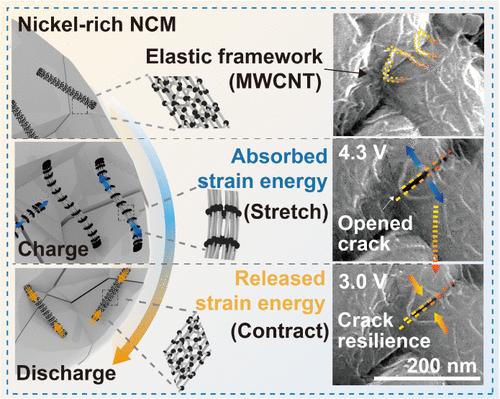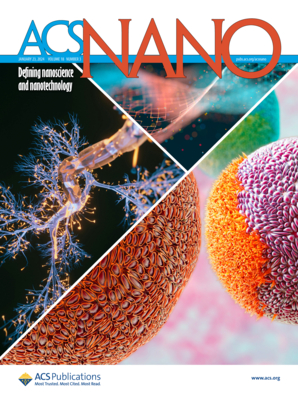Enhancing Mechanical Resilience in Li-Ion Battery Cathodes with Nanoscale Elastic Framework Coatings
IF 15.8
1区 材料科学
Q1 CHEMISTRY, MULTIDISCIPLINARY
引用次数: 0
Abstract
Lattice volume changes in Li-ion batteries active materials are unavoidable during electrochemical cycling, posing significant engineering challenges from the particle to the electrode level. In this study, we present an elastic framework coating designed to absorb and reversibly release strain energy associated with particle volume changes, thereby enhancing mechanical resilience at both the particle and electrode levels. This framework, composed of multiwalled carbon nanotubes (MWCNTs), is applied to nickel-rich LiNi0.9Co0.05Mn0.05O2 (NCM9055) cathodes at a low loading of 0.5 wt %, effectively mitigating critical issues such as particle cracking, volume changes, and electrode thickness variations during cycling. Leveraging these advantages, an energy-dense electrode is achieved with a high active material loading of 20 mg cm–2, without the need for additional carbon additives. Demonstrated in a pouch cell format, this electrode achieves an exceptional capacity retention of 77.7% after 1000 cycles. This approach provides a comprehensive solution for designing Li-ion batteries capable of withstanding lattice volume variations, offering valuable insights for next-generation batteries technologies.

纳米级弹性框架涂层增强锂离子电池阴极的机械回弹性
在电化学循环过程中,锂离子电池活性材料的晶格体积变化是不可避免的,从颗粒到电极水平都带来了重大的工程挑战。在这项研究中,我们提出了一种弹性框架涂层,旨在吸收和可逆地释放与颗粒体积变化相关的应变能,从而提高颗粒和电极水平的机械弹性。该框架由多壁碳纳米管(MWCNTs)组成,在0.5 wt %的低负载下应用于富镍LiNi0.9Co0.05Mn0.05O2 (NCM9055)阴极,有效缓解了循环过程中颗粒开裂、体积变化和电极厚度变化等关键问题。利用这些优势,高活性材料负载为20 mg cm-2,无需额外的碳添加剂,即可实现能量密集电极。这种电极在1000次循环后达到了77.7%的特殊容量保留。这种方法为设计能够承受晶格体积变化的锂离子电池提供了一种全面的解决方案,为下一代电池技术提供了有价值的见解。
本文章由计算机程序翻译,如有差异,请以英文原文为准。
求助全文
约1分钟内获得全文
求助全文
来源期刊

ACS Nano
工程技术-材料科学:综合
CiteScore
26.00
自引率
4.10%
发文量
1627
审稿时长
1.7 months
期刊介绍:
ACS Nano, published monthly, serves as an international forum for comprehensive articles on nanoscience and nanotechnology research at the intersections of chemistry, biology, materials science, physics, and engineering. The journal fosters communication among scientists in these communities, facilitating collaboration, new research opportunities, and advancements through discoveries. ACS Nano covers synthesis, assembly, characterization, theory, and simulation of nanostructures, nanobiotechnology, nanofabrication, methods and tools for nanoscience and nanotechnology, and self- and directed-assembly. Alongside original research articles, it offers thorough reviews, perspectives on cutting-edge research, and discussions envisioning the future of nanoscience and nanotechnology.
 求助内容:
求助内容: 应助结果提醒方式:
应助结果提醒方式:


